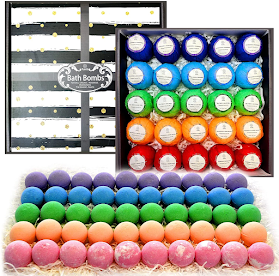Chapter 1: The Origins and Evolution of Bath Bombs
- Historical origins: tracing the
roots of bath bombs back to ancient civilizations such as the Egyptians
and Romans.
- Evolution in modern times: the
resurgence of bath bombs in the 20th century and their transformation into
a popular self-care product.
- Women's bath bombs: how they have
been uniquely formulated to cater to the specific needs and preferences of
women, incorporating feminine scents and nourishing ingredients.
Chapter 2: The Science Behind Bath Bombs
- Understanding the basic components:
the key ingredients that make up a bath
bomb, including baking soda, citric acid, and essential oils.
- The fizzing reaction: how bath
bombs create a fizzing effect when they come into contact with water,
releasing nourishing oils and fragrances.
- Skin benefits: the moisturizing and
soothing properties of bath bombs, and how they can help alleviate dry
skin, inflammation, and stress.
Chapter 3: Benefits of Women's Bath Bombs
- Stress relief: the calming effects
of essential oils such as lavender and chamomile, which can help alleviate
anxiety and promote relaxation.
- Skin hydration: how bath bombs
infused with ingredients like shea butter and coconut oil can deeply
moisturize and nourish the skin, leaving it soft and supple.
- Aromatherapy benefits: the
mood-enhancing properties of aromatic scents, which can uplift the spirits
and promote emotional well-being.
- Muscle relaxation: the therapeutic
effects of bath bombs containing Epsom salt, which can help soothe sore
muscles and alleviate tension.
Chapter 4: Choosing the Right Women's Bath Bomb
- Scent preferences: considering your
favourite fragrances and aromas, whether you prefer floral, fruity, or
herbal scents.
- Skin type: selecting bath bombs
formulated with ingredients that cater to your specific skin type, whether
it's dry, oily, sensitive, or combination.
- Additional features: exploring bath
bombs with added features such as glitter, botanicals, or moisturizing
agents for an extra luxurious experience.
- Allergies and sensitivities:
checking the ingredient list for potential allergens and irritants,
especially if you have sensitive skin or allergies.
Chapter 5: How to Use Women's Bath Bombs
- Preparing your bath: filling the
tub with warm water to the desired level, ensuring it's at a comfortable
temperature.
- Adding the bath bomb: gently
dropping the bath bomb into the water and watching it fizz and dissolve.
- Enjoying the experience: sinking
into the luxurious bath, allowing the aromatic scents and nourishing oils
to envelop your senses and pamper your skin.
- Post-bath care: patting your skin
dry with a soft towel and moisturizing with your favourite body lotion or
oil to lock in hydration.
Conclusion:
Women's
bath bombs offer a blissful escape from the
stresses of daily life, providing a luxurious and indulgent self-care
experience. From their origins in ancient civilizations to their modern-day
resurgence, bath bombs have evolved into a beloved staple of pampering rituals
around the world. By understanding the science behind bath bombs,
exploring their myriad benefits, and choosing the perfect one for your needs,
you can elevate your bath time routine to new heights of relaxation and
rejuvenation. So go ahead, treat yourself to a women's bath bomb and immerse
yourself in a world of luxury and self-care.




No comments:
Post a Comment